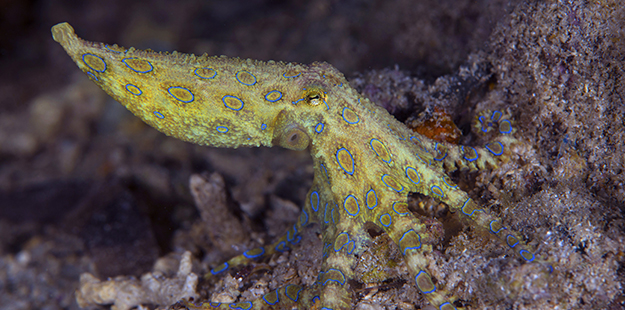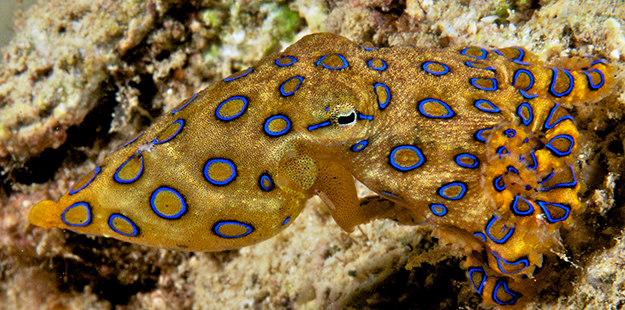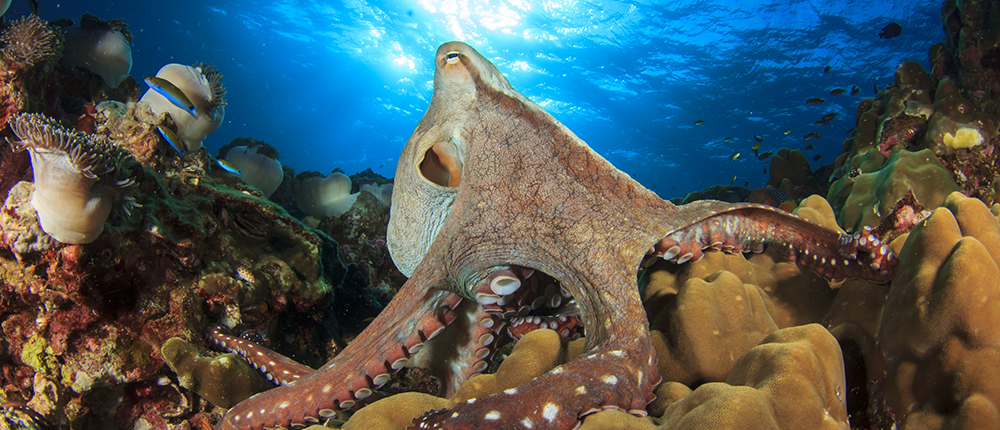Three Hearted Blue Bloods
Amazing impersonators
Rather than hide, some animals use misdirection to deter a would-be predator. One of the most common misdirection strategies is to look like something else–preferably something unsavory or poisonous. The undisputed master of this craft is the mimic octopus. Unknown to science until the late 1990s, this creature has an amazing ability to transform itself and imitate a wide range of sea creatures. With a quick color change, the addition of some body stripes and a reposition of tentacles to resemble spines, a mimic can create the appearance of a venomous lionfish. Tuck those same tentacles together and flatten the body, and the mimic takes on the look of a poisonous flatfish as it glides along the sea floor. If caught in open water, a mimic may puff up its head and siphon while allowing its tentacles to trail in behind as in impersonates the movements of a jellyfish.

Unknown to science until the late 1990s, the Mimic octopus features perhaps the most amazing set of behaviors known among all family of octopi. Photo by David Evison
If threatened, a mimic may run for shelter, but once it finds sanctuary, it’s likely to extend two tentacles in opposite directions while turning the skin to bands of white and black. This creates the illusion of a deadly sea snake, something most predators will give a wide berth. The mimic’s talents aren’t confined to defense. By taking on the shape and coloration of an anemone or sponge, they can lurk undetected until prey passes close by.
Octopus can rapidly change their color and skin patterns, even morphing the shape and texture of it to match their surroundings. This is because their skin cells, known as chromatophores, can alter the color, opacity, and reflectivity of the epidermis.
In an especially neat act of deception, it can transform itself into the profile of a crab, luring a potential mate close, then, striking. In all, mimics have been known to impersonate more than two-dozen different sea creatures, and their behavior continues to fascinate marine scientists. Because they prefer coastal shallows, snorkelers exploring Wakatobi’s grass beds and lagoons are actually more likely to encounter a mimic than are divers on the reefs.
Deadly ringers
The blue-ringed octopus is preceded by an infamous reputation as one of the most toxic creatures in the sea. When provoked, this octopus can administer a potent dose of the toxin known as Tetrodotoxin. A mere milligram of this poison could kill a human, and there is no known antidote. But before you run screaming from the water, know that very few humans are actually killed by blue-ringed octopus, and in most instances, it was a case of self-defense by an animal that was stepped on or molested. It’s not surprising that bare feet are a target, as this octopus prefers shallow waters, whether along the top of a reef or amid a nearshore rubble field.

The Blue-ringed prefers shallow waters, whether along the top of a reef or amid a near shore rubble field, such as this one, photographed at the site Magic Pier, visited by Pelagian dive yacht. Photo by Nigel Wade

Look, don’t touch and you’ll enjoy the incredible beauty of the blue-ringed octopus. Photo by Steve Rosenberg
Blue-ringed’s are daytime feeders, spending their time hunting for shrimp, crabs, and small fish. Their normal coloration ranges from a dull yellow to brown, in patterns that blend into the surroundings and make them quite difficult to spot. The vivid blue rings that give this species its name show up only when the animal is feeling provoked, and that’s when you want to keep your distance. The blue-ringed octopus also produces a second and far less lethal type of poison, which is used to subdue prey. If you are lucky enough to see one at Wakatobi, just remember to maintain a respectful distance, and to look but not touch.
Wonders of the night
One of Wakatobi’s least understood residents comes out at night. At first glance, the wonderpus (seen featured at the top of this article) could be mistaken for a mimic octopus. But they are smaller and have longer, thinner tentacles that are up to seven times the length of their body. In addition, they come out primarily at night, while the mimic is active during the day. The wonderpus doesn’t share the mimic’s shape-shifting abilities and instead relies on a combination of concealment and chemical warfare for its defenses. These animals can administer a potent poison to would-be attackers, and when threatened, its normally subdued reddish brown color patterns will light up in vivid colors, advertising the toxic dangers that await. No two members of this species have the same patterns of stripes and spots, which makes it possible for observers to identify individuals within a population. Beyond these facts, much about the wonderpus remains unknown. If you happen upon one during a night dive at Wakatobi, be sure to take photos and video, because you might document some new behavior that will further our understanding of these creatures.
Whether they are stalking a lunch, hiding to avoid becoming dinner, or just moving about the reefs, once your eye becomes accustomed to spotting them, you will begin see the three-hearted blue bloods more and more frequently on dive sites. And if you don’t you can always ask one of the resort’s dive guides to point one out. Have your camera ready, because you are likely in for a show.
A visit to Wakatobi is a rare opportunity to immerse yourself in nature at its finest and most pristine, and see and learn about the weird and wonderful creatures that inhabit our reefs. It’s time to experience all that Wakatobi has to offer! Contact us at office@wakatobi.com or complete a quick trip inquiry at wakatobi.com.
Visit us on Facebook and Instagram
Wakatobi on YouTube
Contact us – Enquire


